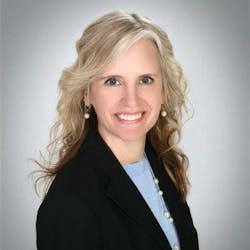5 tips, trends and predictions for industry: A conversation with Women in Manufacturing Hall of Fame inductee
Key Highlights
- Women in Manufacturing (WiM) Hall of Fame inductee Ann Franzen has risen from shop floor engineer to vice president, managing 10 manufacturing plants and driving operational excellence at USG.
- She emphasizes the importance of flexibility, boldness, and continuous learning in navigating the dynamic manufacturing landscape.
- The company leverages advanced predictive maintenance and artificial intelligence (AI) technologies to enhance reliability and prevent costly downtimes.
- Franzen advocates for diversity and inclusion, founding WiM activities at USG and supporting initiatives that promote gender equity and professional growth.
Ann Franzen is vice president of manufacturing at USG’s ceilings division, and has been with the company for 30 years. She started as an engineer just out of college working the shop floor in one of USG’s manufacturing plants, and now she runs 10 plants for the building materials manufacturer. USG holds more than 70 locations, including manufacturing plants, distribution centers and headquarters, across USG, CGC and USG Latam.
“There’s a reason that I’ve stayed with USG,” Franzen says, having worked in product management, plant operations, and executive leadership over her USG career. The company has been around for more than 100 years, serving the construction industry and inventing and innovating building materials like sheetrock. While Franzen works in the ceilings division, she also spent 24 years on the gypsum side of the business, which is the raw material that is used to manufacture sheetrock.
Overall, USG is focused on advancing products that bring efficiencies to construction sites, projects, and workers. “We continue to listen to our customers and innovate new products that make their jobs easier, so that they can get in and off of jobs at a faster rate,” Franzen says.
Each USG manufacturing plant has a 10-year sustainability plan, focused on reducing greenhouse gas emissions and reducing overall waste. “We have goals around each of those in each of our businesses and have taken it down to each plant level, so that each plant is contributing and knows how they're impacting the overall goals that we've set for the company. So, we have had a major focus on that in the last few years,” Franzen says.
1. Lessons learned: be flexible and be bold.
Q: What are some lessons from the plant floor that continue to shape your decision-making today?
A: I would say the ability to be flexible. I think in manufacturing, things change on a dime. It's very dynamic, whether you're in production, whether you're in maintenance. You have to be flexible, and you can't be afraid to tackle different challenges, and you have to be bold sometimes in learning and stepping out of your comfort zone and learning new things.
Franzen was the first woman at USG to serve as a plant manager and later as a vice president, but her journey hasn’t focused much on breaking glass ceilings because USG provided an environment with no ceiling to break.
“I will tell you that I was never treated any differently. My expectations were the same. USG places a high focus and emphasis on diversity and understands the importance of diversity and what that does for our culture in creating more innovation and in having better decision making,” Franzen says. “Being the only person that is a little bit different in the room is always challenging.” However, Franzen always had support from men and women in and outside of USG. Thirteen years ago, Franzen was a founding member of a Women in Manufacturing group at USG, which is still active today. “I’m very proud of the work we’ve done to try and improve our diversity,” Franzen says.
2. Personal and organizational continuous improvement is a game changer for USG success.
Franzen calls continuous improvement a “game changer” for USG. “You don’t know where your issues are until you start to highlight them, and whether it be through waste, whether it be through unplanned downtime, all that gets highlighted through the continuous improvement process,” she adds. “You can’t get better if you don’t know where your issues are, and that process highlights it in all areas of your operation.”
For example, at USG’s Fort Dodge gypsum plant, the process identified sources of delay within the bag inserter, fill station and carton former, which was reducing production efficiency. As the plant looked into root causes of the issue, it quickly discovered some important missing components: standard work and preventive maintenance. With consistent standards as the starting point, then, the tools and the process can identify where improvements were needed. For the Fort Dodge gypsum plant, it needed to replace a worm auger, adjust the timing at the fill station, and improve carton variation coming from the vendor.
3. Maintenance and reliability: technology is changing the industrial landscape and the workforce.
Q: What maintenance and reliability best practices does USG use for engaging technicians and operators?
A: Where we have systems, we understand the importance of preventative maintenance and how do you get ahead of the issues that can arise—whether it be through operating hours on the equipment, whether it be through wear-and-tear—how do we get ahead of having unplanned downtime. Each of our plants does audits to see how we are doing and monitor KPIs around each of those types of metrics. We look at that on a monthly basis—how many work orders we are doing, how much unplanned downtime did we have, and how do we try to make those improvements through our reliability model at each of our locations.
For example, the USG Jacksonville gypsum plant avoided a major rebuild of the ball mill through predictive and preventive maintenance. Predictive maintenance software from Prometheus detected an anomaly in the ball mill drive components, showing an increase in the drive amps. The upward trend was also slowly increasing, which put it at risk for failure. Through the data, the plant discovered that the automatic lubrications system was using an oil with a viscosity that was not suitable for the pressures in the gear drive, causing excessive wear on the gears. Because the drive system can run either way, the plant reversed the ball mill to drive on the non-worn side of the gears with the correct lubrication in place.
“We used predictive maintenance at our Jacksonville plant to detect rising drive amps in the ball mill before a failure occurred. The data pointed us to a lubrication issue, so we reversed the drive, corrected the oil viscosity, and updated preventive maintenance and training. By acting on the insight, we avoided a costly rebuild, canceled more than $70,000 in parts orders, and prevented hours or days of downtime that would have affected our customers,” Franzen says.
The next step in predictive monitoring at USG is using artificial intelligence to do more predictions. AI can do data analysis quicker and more comprehensively, and it can provide a list of what might be happening on problem assets for maintenance to investigate further. “The use of AI tools is becoming more prevalent at each of our locations,” Franzen says.
AI is also becoming more a part of decision-making, where human error can muddle projects. “It’s odd to think about, but the industry is changing so rapidly that you can use AI to predict how your product is going to be manufactured,” Franzen says. AI is often thought of as replacing low-level work, but USG is also looking for ways to take more risk out of decision-making.
Advanced technologies have brought challenges too, particularly with a changing and tightening workforce. Companies must be more flexible in how they hire and how they train and develop talent, Franzen says, to meet the changing labor and skills needed.
4. Advice for young engineers: manufacturing is for the creative and innovative.
Q: How has manufacturing changed over your career?
A: When I started 30 years ago, things looked a lot different than they do today. A lot in our manufacturing plants, a lot of manual processes 30 years ago, you relied on muscle to move things, to get things done, where today we use a lot of technology. Automation has advanced and looking at how we do things in our plants has changed for the better.
USG partners with local high school, community colleges, and trade organizations to strengthen those relationships and help individuals interested in a career in manufacturing. Internally, USG is focused on training employees faster and giving them the ability to adapt to changing technologies. “It’s a different skill than it was 30 years ago,” Franzen says.
Q: What advice would you give to young engineers or technicians entering manufacturing today?
A: I would tell them to establish a career in manufacturing. I think a lot of times manufacturing gets overlooked, but if you have a desire to be creative, to be innovative, to be able to leave your mark on an industry, manufacturing is really an awesome outlet for that.
5. Women in Manufacturing Hall of Fame award: step out of your comfort zone.
Franzen has taken on some challenging and difficult assignments in her career, which helped her grow and adapt. “Some of my advice to those coming up through manufacturing, is you can't be afraid to tackle new challenges, step out of your comfort zone, learn different processes, take on those harder assignments so that it really helps you learn and develop, and really grow as a person and a professional,” Franzen says.
Q: How does it feel to be recognized among such a distinguished group of industry leaders?
A: I'm completely humbled and honored with the recognition. There are ten other women that are being recognized with me and it's a national organization. To think that through my career that somewhere along the way I inspired other people or helped people develop and learn, it's really humbling, and I'm really honored to be recognized with such talent in the industry for sure.
Part of the selection criteria for the Hall of Fame emphasizes paving the way for future generations and promoting inclusive workplaces, and Franzen has been an integral part of this at USG. As a founding member of the company’s Women in Manufacturing group, she has developed connections through forums, mentor programs, and starter kits for new female engineers.
“I’m really proud of that because our numbers have increased, and I think it’s provided support and mentorship for all of our women that are working at USG,” Franzen says.
USG Women in Manufacturing starter kits welcome new hired of all genders to the team and help foster pride and connection from day one. Each kit includes branded items and a handwritten note that introduces WiM, highlights employee resource groups, and encourages new employees to explore opportunities for engagement and support.
“This year, USG proudly opened Women in Manufacturing National Association membership to all employees. We now have 172 colleagues from diverse backgrounds, actively engaged, helping advance women in manufacturing. The initiative supports USG’s goals for industry leadership, professional development and stronger community connections,” Franzen says.
About the Author

Anna Townshend
managing editor
Anna Townshend has been a journalist and editor for almost 20 years. She joined Control Design and Plant Services as managing editor in June 2020. Previously, for more than 10 years, she was the editor of Marina Dock Age and International Dredging Review. In addition to writing and editing thousands of articles in her career, she has been an active speaker on industry panels and presentations, as well as host for the Tool Belt and Control Intelligence podcasts. Email her at [email protected].

